~ The Study of Threes ~
http://threesology.org

Visitors as of 19th Feb 2020
| Preface page 1 | Preface page 2 | Preface page 3 |
| Preface page 1b | Preface page 2b | Preface page 3b |
| ANC Prologue Page 1 |
ANC Prologue Page 2 |
ANC Prologue Page 3 |
| ANC Prologue Page 1b |
ANC Prologue Page 2b |
ANC Prologue Page 3b |
| Communism and Societal Collapse |
| ANC Epilogue Page 1 |
ANC Epilogue Page 2 |
ANC Epilogue Page 3 |
Communism has brought about the collapse of many societies. We need to take a serious look at this and develop a new hypothesis in order to create a New Communism and not a distorted copy of a copy of a copy which has thus far produced tragic results. With the need to develop a new hypothesis for Communism, different models may well be tried out as an intellectual exercise. For example:
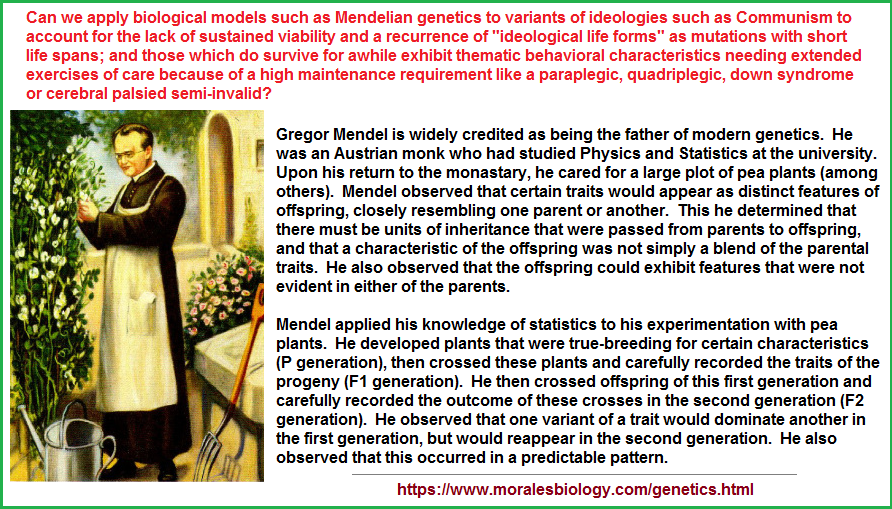
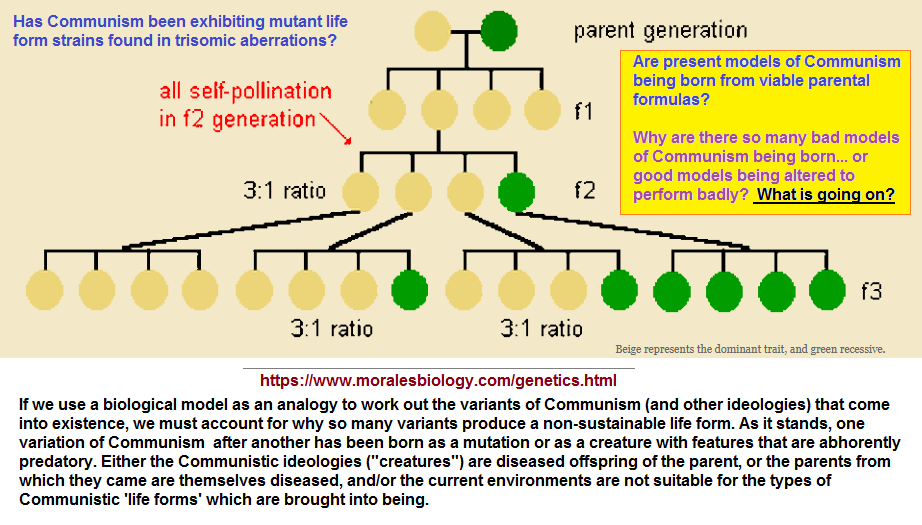
In providing the example of a biological model, I am confronted by some who are misinterpreting my application as a suggested supposition and not trying to assert a definitive means of explaining why Communism very often appears to represent some distorted creature with a functionality resembling a sick or deformed entity because of all the death and destruction which arise by way of predation and what gives the impression of being a "chip-on-the-shoulder" confrontational attitude suggesting an effort to conceal flaws or short-comings by way of attempted over-compensation. Whereas one might also suggest the usage of the terms "Organic model," "Mathematical model," "Mechanical/machine model," "Chemical model," "Atomic particle/quantum model," "Gaming model," "Group behavior model," "Social dynamics model," etc., since many of these could well be viewed in Communistic, Socialistic, Democratic, etc., terms. (See for example: Social Organism). The point is to find a model by which we can better understand why Communism is failing to provide humanity with a better way of life if it is indeed representative of the best social plan of organization. If it is so obviously good, why can't the whole of humanity recognize this and instead views it in terms of its past behavioral antics within the parameters of different variations? Why so many variants that are bad if it is inherently good? The usage of models are meant as metaphors, not word-for-word exact representations.
When we view Communism in terms of being a:
- Mathematical model: recurring ideas have lead us into negative/loss ("in the red") territory.
- Chemical model: recurring mixtures of ideas have produced toxic results.
- Atomic/quantum model: recurring interactions create alternating implosive and explosive situations.
- Mechanic model: recurring high maintenance requirements only forestall problematic functionality of faulty social' equipmentage'.
- Social Dynamics model: attempted artificialized routnizations breed insurmountable conflicts.
- Gaming model: A fixed system evolves to promote centralized elitism for a few resembling a pyramid scheme.
- Organic model: Mutations, aberrations, idiosyncratic gains and losses develop sustained disenchantment, discord and dissolution.
- Group behavior model: Competing groups chase each others tails preventing progress of the whole.
While some try to use different models to effect a positive perception of Communism, and will use their respective model as a philosophy promoting some idealized possibility, the models retain a "do-it-yourself" emphasis that reads like a multi-language brochure thrown into a box meant to assist the consumer in constructing a product that is sold in an "as-is" state of partial assembly, but the language and illustrations in the brochure are written by those who have never attempted to construct the product themselves with the intent of using the product in their own lives. It is meant for others whom they don't know, will never have contact with, and are merely performing a function of a company whose officers delegate authority to others so they can spend the afternoon playing golf as "absentee managers" whose primary concern is for their own profit and are enabled to go elsewhere very quickly if the company folds under.
In discussing the incremental deterioration of the planet Earth (aside from current Socio-political topics of concern), and the eventual need for humanity to seek some effort to establish a united front against the assaults on human existence such deteriorations will entail (and taking place right now), it is of need to point out that the deterioration of the species also involves the incremental deterioration of civilizations, though this extends downwards into smaller groups and the individual as well. Some civilizations, some small groups, some individuals are merely highly sensitive to the deteriorations and thus are differently affected to the extent they have difficulty in formulating some means of adopting a viable type of equilibrium under the context which they are being subjected to. This does not mean that they could not find an "affordably viable" type of well-being (mental, emotional, physical, financial, social...) elsewhere during their respective time period of living. In fact, many find a more desirable way of life outside their original birth place amongst those who are not blood related.
Discussions about Communism do not routinely involve the mention of Societal Collapse because Communists and all other Socio-political doctrines (anarchy notwithstanding) want to project a positive perception for the inclusion and practice of their ideology. The idea of "Societal Collapse" has been popularized by Jared Diamond
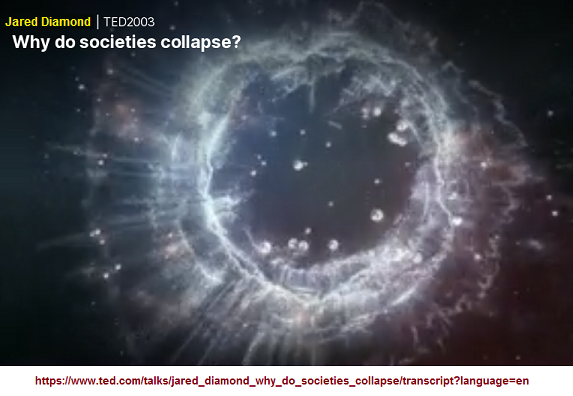
Why do Societies Collapse
What Mr. Diamond is not taking into consideration, or at least not making a point of, is that humanity from its inception... in fact, all of life.... was born in "survival mode" requiring it to make behavioral adjustments in response to the environment. Because the environment was born in a "incremental deterioration" mode forcing life to adopt survival strategies in-tune with prevailing conditions of a life-form's era of existence, life forms are thus mirror-images of the environment to which they learned to adapt to. However, if we say that the triplet code of DNA is the same today as it was thousands, or millions or billions of years ago, then they may well be some other-than-the typical "garden variety" of influence which is sustaining it and keeping it from changing. The collapse of societies which all previous one's have and all present one's are undergoing, may be reflections of the deteriorating environment. Since humanity is a "monkey see monkey do" type of myna bird which parrots not only others but other life forms as well in both name and activities, humanity may well be exhibiting an unrecognized influence of deterioration taking place with the environment. The idea of a Mirror Neuron may come to mind since the idea of mirror imaging perception with activity is being speculated on, whether or not these neurons exist in humans as well as monkeys.
Communism is one of the links in the chain of events which are part of the ensemble of events which bring about the collapse of a society. Either in the presence of an actual practice or a presumed absence of a clearly identifiable role, Communism and all other Socio-politico-economic ideas come into play. This is true for religion and science as well, though some readers may prefer to think in terms of an absence of that which they prefer to advocate. Whereas some would like to think that the idea of a presumed "true Communism" represents an idyllic Utopia for which there is no other idea to be compared with as having a similar level of uniqueness, they forget to remind themselves that Communism can be twisted and molded to fit the ideological preferences of anyone who is orientated towards a self-interest though they may claim it is a self-interest with the best intentions for everyone. Varieties of Communism have been used to bring about the downfall of societies, just as have varieties of Democracy, Socialism, Libertarianism, religion, science, etc... Whereas all beliefs become subjected to a molding process in an effort to adapt it to a given era in an effort to keep it viable, every single society has come to collapse. Whereas Mr. Diamond does not contemplate Japan as having undergone a collapse since a place and people respectively named Japan and Japanese continue to live, the previous ways in which they lived have been subjected to incremental forms of decay and dissolution. The Japan of the 1st Century is not the Japan of today, and even before Japan was even know as Japan or the people referred to themselves as Japanese; those of the past are dead. In other words, all previous forms of the Early Japan collapsed and were replaced. A people and a country name do not need to become extinct for the people and country to experience a collapse or an extinction.
Humans have occupied Japan for tens of thousands of years, but Japan's recorded history begins only in the 1st century BCE, with mention in Chinese sources. Contact with China and Korea in the early centuries CE brought profound changes to Japan, including the Chinese writing system, Buddhism, and many artistic forms from the continent. The first steps at political unification of the country occurred in the late 4th and early 5th centuries CE under the Yamato court. A great civilization then developed first at Nara in the 8th century and then at Heian-kyo- (now Kyo-to) from the late 8th to the late 12th century. The seven centuries thereafter were a period of domination by military rulers culminating in near isolation from the outside world from the early 17th to the mid-19th century.
The reopening of the country ushered in contact with the West and a time of unprecedented change. Japan sought to become a modern industrialized nation and pursued the acquisition of a large overseas empire, initially in Korea and China. By late 1941 this latter policy caused direct confrontation with the United States and its allies and to defeat in World War II (1939–45). Since the war, however, Japan's spectacular economic growth—one of the greatest of any nation in that period—brought the country to the forefront of the world economy. It now is one of the world's foremost manufacturing countries and traders of goods and is a global financial leader.
Akira Watanabe- Chairman, Department of Geography, Ochanomizu Women's University, Tokyo. Editor of Gazetteer of Japan.
Gil Latz- Professor of Geography, Portland State University, Oregon. Author of Agricultural Development in Japan: The Land Improvement District in Concept and Practice and others.
"Japan." Encyclopædia Britannica Ultimate Reference Suite, 2013.
Without contact to other peoples, with little relative change to the environment (such as increase or decrease in resources), it is difficult to say how a group of people might develop on their own. If the Japanese did not have an influx of ideas from the Chinese and others and remained to this day as an isolated island, the Japanese might well be a very primitive people who are otherwise adept at copying the behavior of others, but are not able to initiate that which they learn. The same goes for all social groups on planet Earth. If no group ever acquired contact with any other group, humanity might well be in a pre-industrial state of existence. Then again, some contact scenarios led to a decimation due to disease or war. Because so much of human behavior is based upon mimicry, varieties of Communism and other ideologies spring up as mere renditions of some presumed ideal presented by someone or some group, though their belief is most likely a rendition of a rendition of a rendition, thus expressing a copy of a copy of a copy, which when looked at in terms of a copy machine representation, provides clear evidence of an increasing distortion. As it stands, humanity does not easily see how distorted it has become in its genetics and routinely subjects an increase in distortions to a percentage count which obscures the reality of an overall diminishment. There are no "genuine humans" being born and no original ideas; and the effort to suggest a person or idea as an originality often leads its advocates to promote a rigidity that affords them an ability to exclude or include those a small leadership wants to assist or detour. For example, a person's presumed ability to do something is labeled that of a genius, whereby the person is used as a standard by which others are measured; disallowing for a greater genius in a different subject area to be adequately recognized.
The more and more people try to copy some rendition of Communism, or Democracy, or Socialism, etc., the copies of the copies of the copies increase the rate of distortion that practitioners in a society can not readily recognize because they are most likely born into the situation and know of no other better value. Copying some past rendition of Communism, or Democracy or Capitalism will lead to a collapse. Only by creating a new model can a basic idea of Communism be able to survive. Unless humanity wants to invent and practice a system of cloning like ants, bees and termites— though these models may well be distortions of the former patterns— humanity must originate a new model for re-creating itself. Simply using a variation of Democracy on the heels of some former Democracy with or without Capitalism, will eventually lead to a demise. Distinctly new forms of Democracy and Capitalism are not being born simply by a change in a business, political or religious community. New forms of copies, yes,... but not entirely new blueprints. Like building a foundation on an old settlement; whereas we may give ourselves the impression that we have created something new, we in fact have covered up one collapse with the beginning of yet another societal collapse in the making.
Since distortion is widely known and understood with respect to electronically produced copies— as when one uses a copying machine to make a copy of a page— the usage of a computer to make copies of files has addressed the issue in as much as we are able to detect no distortions due to what is sometimes described as Generation Loss. The problem is that humans are not machines and make alterations not only in the initial creation, but in the retelling of the original. Whereas some may want to describe the alterations as exhibits of individuality and if not creativity or genius, the fact remains that ideologies such as Communism are subjected to a process which distorts the original idea, and in fact if Marx were enabled to re-tell his ideas over and over again, no two reproductions would be the same. Though some think that a sequel (such as in the case of a motion picture) is better than the original, there nonetheless is a representative difference. Communism's role in societal collapse is no doubt due to the original ideas of communalism and Commonism being distorted not only by those attempting to apply what they think communalism and Commonism mean, but also apply the original ideas in the context where the original idea was not formulated in the first place. And this is where the idea of an ideological "practice" come into play. Because the different generations of humans are no doubt undergoing their own types of distortions through the copying of DNA, even if we are not acutely aware of any genetic changes, the original Communism... as one might suppose it had once existed in a pristine state; has been altered over time. What we see today are degenerate models of Communism just as we see degenerate models of Democracy, Socialism, Monarchy, etc...
The following example of generation loss (with respect to an image) gives some idea what I am describing about the usage of copying the copy of a copy of an ideology such as Communism:
Generation loss at quality 97 or higher
It is easy to recognize the changes when using time elapsed imaging but not so easy when the copies take place at several generations removed from the original and when the copies undergo not only translation into a different language but a different culture as well, whose uses may be more... or less educated and more... or less experienced than those who used a previous version which was also a copy. In addition, the distortions may undergo a reinterpretation whereby they are described as some "ancient wisdom" or "ancient truth" and presented to others in a form and format meant to suggest some level of extra-ordinary greatness such as when a report is placed into a glossy folder and handed out at a meeting with others dressed in business suits. Distortions may well be excused and minimized and even excused as part of some previously significance, and be handled with the utmost care like an artifact or old painting that is subjected to a process and procedure of cleaning and restoration costing many times the salaries most people ever receive. No less, the originator may be to some degree deified and thus anything and everything that they supposedly said is to be sanctified as an absolute truth... without question.
This is why I say we need a New Communism, (and not a copy of a copy of a copy as has been the historical routine); though some readers will want to claim we need a New Democracy, or some other New idea in order to keep humanity from simply creating yet another rendition that forestalls but does not stop an eventual demise. While the idea of a New Democracy or even an "Actual" or "Real" Democracy has been discussed as a necessity to combat the very many distortions the peoples of the world are being confronted with by way of all the phony democracies being practiced, the fact is we don't know what a "True" Democracy actually means. However, to give an imaginative analogy of what we might be confronted with... is the future occasion where a single monkey is born with the ability of one (or several) Einstein's and other noted scientific figures in other subject areas, but all other monkeys remain as they are.
Note: with respect to Einstein's 1905 papers:
At first Einstein's 1905 papers were ignored by the physics community. This began to change after he received the attention of just one physicist, perhaps the most influential physicist of his generation, Max Planck, the founder of the quantum theory. Soon, owing to Planck's laudatory comments and to experiments that gradually confirmed his theories, Einstein was invited to lecture at international meetings, such as the Solvay Conferences, and he rose rapidly in the academic world. He was offered a series of positions at increasingly prestigious institutions, including the University of Zürich, the University of Prague, the Swiss Federal Institute of Technology, and finally the University of Berlin, where he served as director of the Kaiser Wilhelm Institute for Physics from 1913 to 1933 (although the opening of the institute was delayed until 1917).
Michio Kaku: Professor of theoretical physics, City University of New York. Author of Hyperspace, Visions, Beyond Einstein, and Einstein's Cosmos.
"Einstein, Albert." Encyclopædia Britannica Ultimate Reference Suite, 2013.
See also: Why No One Believed Einstein (Einstein's theory of relativity presented a direct challenge to the notion of ether.)

In other words, of what value is it to have one or a thousand brilliant people if there are billions who can neither appreciate nor understand their genius to put their ideas into practice... like having a brilliant politician in a government but everyone else is an idiot. Whereas someone reading this may well have an original idea, of what value is it if no one else can understand it, or they can not find a means to explain their idea in such a way for a majority to place a value on it of great importance? Even if the reader of this has a marvelous idea concerning a better social system, of what value is it if no one is given a chance to see it, much less can understand it if they got a chance to see it anyway? Even when we have thousand of citizens and scientists calling for immediate efforts to tackle climate problems, how are we going to address the necessary issues if we have to deal with governments, businesses and religions that view the changes as a means by which they can better solidify their personal beliefs? For example, why stop a war if one is positioned to make a fortune off of it? Why stop a human calamity if the resulting dire circumstances force people to seek out comfort in a religion that will then be enable to increase its funding? Why intervene in the incremental decay of a society if it permits a government to continue its efforts at social control? Those is the Stock Market could care less what tragedy in the world takes place so long as they can make more money. In terms of attempting to get others to "understand" someone's version of Communism, the typical methodology has been to exert a demand by way of force... even to the extent of killing those who do not comply with a vision that has invariably turned out to be a version of yet another distortion... a copy of a copy of a copy over generations of copies that are not easily recognized as being the distorted copies of other copies because the recognition there of is lost in translations, applications, contexts, eras, cultures, desperation, environmental settings, mobocratic inebriation, etc...
The fact that so many different variations of Communism have failed is due to the application of a distorted copy of a distorted copy. The originators of the variant which creates a societal collapse are refusing to return to a basic configuration and work their way forward without being restricted by the guidelines used by those who had insisted upon using a distorted version in the first place and presented their distortion in a glossified folder in the context where those who were listening were given individualized values of importance to the extent they were deluded and disabled from being able to recognize their version of Communism as being a distortion of reality.
All dead civilizations which are routinely (or not) provided as examples of extinct belief systems, typically involve those characteristically defined by historians as large enclaves of people, though there no doubt is a type of measurement they use even if others do not take this criteria into consideration. Such defining characteristics may be defined by numbers of peoples, the amount of languages spoken, level of commerce, war activity, written accounts, archeological remnants, architectural vestiges, etc... However, as will be seen in the following list (from: https://en.wikipedia.org/wiki/Indigenous_peoples_of_the_Americas), such "civilizations" as Nazi Germany, Mao's Communistic empire, the Pueblo Indians, Neanderthal cultures, the very many gangs, religious communities, clubs, partnerships, etc., are not included, such as that we might provide the review that the conquering Mongol hordes of Ghengis Khan were eventually absorbed into the larger Chinese culture). Actually, there is no telling how many small groups or individualized belief systems (involving business (criminal or otherwise), politics and/or religion) have come and gone, but that we can give an accurate account by saying all of the have become extinct. Indeed, how do we define a civilization if not also by its individualized parts or groups of inter-acting citizens? The same goes for a family unit upon the absence of a family member or that which held the family together.
|
|
|
|
- The Andaman- In 2010, the last living member of the Bo tribe died. The nation was extinct after 65,000 years on the Andaman Islands, an archipelago located in the Indian Ocean. Marco Polo nicknamed the archipelago "the land of the head-hunters." In the 19th century, the British built the world's biggest penal colony, where they sent their political prisoners. Today, the islands are a popular tourist destination.
- The Nabataeans- The famous city of Petra was the capital of Nabataea, a kingdom located in Syria and Jordan. The Nabataeans gave women many rights, including land ownership, which was quite rare at the time. The Nabataeans eventually succumbed to the Roman conquest. Petra, which had up to 20,000 inhabitants, was abandoned after being struck by a violent earthquake in 363.
- The Aksum Kingdom- This empire stretched over 1.2 million square kilometres (slightly larger than Ontario) in Northern Ethiopia. Aksum was an ideal passage for commercial roads connecting the Mediterranean to India. It was the first African state to have its own currency. Its decline was due to a severe drought and land over-exploitation.
- The Mandan- The Mandan are a Native American people who lived in North Dakota and South Dakota. In 1738, the Mandan encountered European colonies. Fur trade was developed between the two parties. However, in 1837, a smallpox epidemic decimated the Mandan, who were then barely one hundred. In order to survive, the Mandan joined two other tribes, the Hidatsa and the Arikara. The last Mandan died in 1971.
- The Etruscans- The Etruscan people lived in the centre of what is now Italy, during several centuries BC. They mastered irrigation and commerce, and became more and more powerful. They rivalled with the Greeks, and transformed Rome into an actual city. The Romans freed themselves, however, and over three centuries, the Etruscans gave ground only to be crushed by the Romans who took their deities (Jupiter, Minerva, Hercules, etc.). Some aspects of Etruscan life remain unknown, since Etruscan scriptures remain indecipherable even today.
- The Phoenicians- The Phoenician people from the Near East were able to develop commerce across the Mediterranean. Excellent navigators, the Phoenicians managed to stabilize their political regime and create coastal trading posts from Syria to Tunisia, where they founded the city of Carthage. For one thousand years BC, the Phoenicians also developed international trade, arousing the interest of neighbouring cultures. But only Alexander the Great was eventually able to take control of Phoenicia.
- The Achaemenid Empire- Settled in the North of what is now Iran, the Achaemenid Empire dominated an entire region of the planet a few centuries BC (560 to 330 BC). Their empire spread across a large part of the Middle East. Hardly centralist, the empire's power gave the provinces autonomy. The empire finally succumbed to the Alexander the Great conquest.
- The Sumerians- The Sumerian people are known for having invented writing and breaking the hour into sixty minutes. From 3000 to 2000 BC, the Sumerian culture developed and allowed its cities to be self-sufficient. Yet, political squabbles and an attack from the neighbouring Elamites put an end to the culture.
- The Vikings- From the 8th to the 11th century, the Vikings endlessly conquered new territories in Europe. Aboard their famous longboats, they landed in England and France, on the Mediterranean coast, and perhaps even in Newfoundland. Eventually, the European kingdoms managed to drive them back to Scandinavia, where they had come from.
- The Haumakas- Easter Island, located off of Chile, had up to 2,500 inhabitants… until European colonies brought over their sicknesses and reduced the population to slavery in the 19th century. A few years later there were only 111 Haumaka people remaining – eight times fewer than the famous moai statues whose fabrication remained a mystery for a long time.
- The Celts- Four hundred years BC, the Celt people inhabited the majority of Western and Central Europe. Their independent tribes mastered metal fabrication. As for their warriors, their preferred combat technique was to scare their adversaries by attacking them head-on, while shouting. However, divided, the Celts were unable to resist the Romans in the first century, which meant the Celt people survived only in Ireland and Scotland.
- The Assyrians- For 15 centuries, Assyria stretched over parts of Turkey, Syria, Lebanon, Iraq, and Iran. Ashur, the capital, was a major commercial city. It reached the peak of its power around 700 BC, when it dominated the entire Middle East, including Egypt. Yet, political squabbles caused the decline of the Assyrian Empire. Its prosperous cities couldn't withstand, and the old empire became essentially rural, dominated by neighbouring kingdoms.
- The Olmec- The Olmec people lived in Central America, from Mexico to Costa Rica, for seven centuries, from 1200 to 500 BC. These jaguar-lovers were passionate about sculptures of the human head. Their civilization remained unknown until the 19th century, when a huge sculpture of a head was found. It inspired cartoonist Hergé, who had it appear in one of his The Adventures of Tintin comics, Flight 714 to Sydney.
- The Anasazi- The Anasazi people lived in the Southwestern United States, many centuries BC. Their villages were built inside huge cliffs. The Mesa Verde National Park, in Colorado, houses the largest Anasazi site: Cliff Palace. It is a structure made up of nearly 200 rooms, built into the rock. We still don't know why the Anasazi people disappeared.
- The Neanderthals- The Neanderthals are a subspecies of the human species. They lived in Europe 30,000 to 28,000 BC, and then disappeared, without any known reason for their extinction. Yet it's possible that some existed at the same time as Homo sapiens… and we might still carry their genes.
- The Incas- The Incas left us Machu Picchu, the incredible site perched in the Andes Mountains. Yet, the Inca tribe ruled the Andes for just three centuries, from the 13th to the 16th. In 1532, the arrival of the first Spanish conquistadors ended the Inca Empire, whose population dropped from 12 million to 600,000 in under a century.
- The Khmer Empire- If you've ever been to Cambodia, in Southeast Asia, you most certainly visited the famous Angkor Wat temple. The structure is remains from the Khmer Empire, which ruled that part of the world for 400 years, before its decline in the 13th century. The empire mastered irrigation and massive architecture. Political squabbles finally led the empire to war, which marked its end.
- The Aztecs- The Aztecs lived in the valley of Mexico for 14 centuries… until the arrival of Spanish conquistador Hernán Cortés. The European war leader wiped out this pre-Columbian culture in under two years. During the following century, the Aztec population dropped from 20 million to under two million inhabitants. The Tenochtitlan site, with its sun and moon pyramids, remains the largest piece of evidence from the culture.
- The Atlanteans- It is still unknown whether or not the Atlanteans were a real population. The city of Atlantis, located on an island off of Greece, was engulfed several thousand years ago. Plato cited this mythical city in his writings and archaeological research has recently been conducted in an attempt to find the site. Whether or not they existed, the Atlanteans remain a popular topic for fans of fantasy literature
- The Mayans- The Mayans ruled Central America for 4,000 years. They had a broad knowledge of astronomy. Their civilization disappeared 1,200 years ago as their cities were gradually abandoned. And today, we still don't know what caused their extinction.
In fact, every different life form, every species of hominid, every bipedal creature of the entire pre-human lineage can be viewed as a type of belief system even if we are not privy to what any of them believed. Such belief systems, whether shared by one or many can constitute a "civilization" so long as we provide the necessary latitude and liberal generosity in our definition. Regardless if we agree or disagree, the point is that all have come and gone just like every single political system that came to be established and thought of as something greater then it actually was, just as the Roman Civilization and all present day political ideologies. They are bound to fail because they are not expansive enough in their thinking to be as readily adaptable as those in such societies think of themselves as being a great nation. All so-called Great Nations have come and gone and replaced with different models that may or may not venture to claim themselves as being great. While many try to adapt, absorbing former ("pagan") ideas so that the labeled specificity is actually a generality, every single present day business, government and religion is on a course of extinction. Expecting one's technology, one's religion, one's evolution to provide a means for a greater adaptation is little more than a fishing expedition of hopefulness. However, different models of hope have shown themselves to be but different programs of adaptation to be measured as a survival mechanism.
A lineage of pre and post-human extinctions is helpful in describing what may be a representation of distorted copies of copies that embraced a genetics that was not viable in the long term, just like the many versions of Communism which have brought about different versions of a societal collapse, and to which we are seeing the same thing taking place with the different variations of Democracy... though the disintegration is taking longer but may be increased by altering the environment in order to force all present day democracies to experience survival modes signaling an eventual extinction. We can compare the many genetic problems contributing to the loss of the Wooly Mammoth as being similar to this idea. The last Wooly Mammoths were copies of copies of copies:

The last wooly mammoths on Earth had disastrous DNA by Laura Geggel

If Communism is to survive it must become more flexible in how it sees itself. Creating the idea of a Communism as a goal creates a system of rigidity that is too inflexible and thus makes itself into a maladaptive survival tool. It must be smart enough to have advocates willing to re-create it with a greater flexibility allowing others to lead when its respective talents are not suitable for a given environmental niche. Communism is one of many different forms of organization that can be used both for good and ill. It is a pathway that can be viable under certain conditions but not all conditions, even when conditions are forced in an effort to sustain a Communism no matter who gets hurt or what gets destroyed. Communism, nor any political ideology, business nor religion are that important. All are survival tools and little more than this. Change the environment and a different belief system may be found that is more suitable, given the types of resources and number of people needing those resources for survival. As it stands, all present day systems of business, government and religion are high energy users. Indeed, if we could go back in time and create an Earthly landscape where no desert existed, we might find that the present day so-called three "great" monotheistic religions (Christianity, Islam, Judaism) would not come into being, because the survival needs of the people may not be as austere as they are in a desert community, and therefore do not need to imaginatively construct an intellectually dependent emotional form of compensation. In other words, these three religions might never have come into being because the environmental conditions would have influenced the minds of people to think differently. However, in the case of a developed Confucianism, Jainism, Shintoism, Buddhism, Hinduism, etc., if we were to subject all their originators to the environment of an isolated island, one must wonder what sorts of ideas might have unfolded.
Unfortunately, the different forms of religion and morality are not customarily viewed as behavioral responses to different climatic terrains.
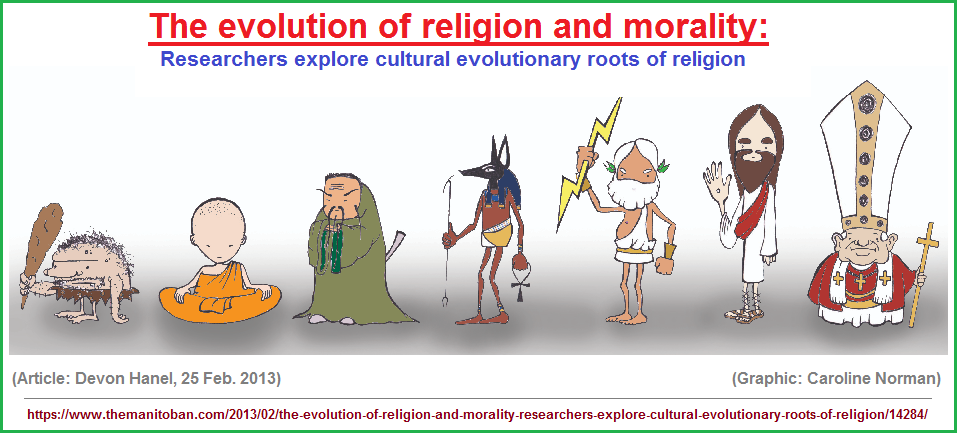
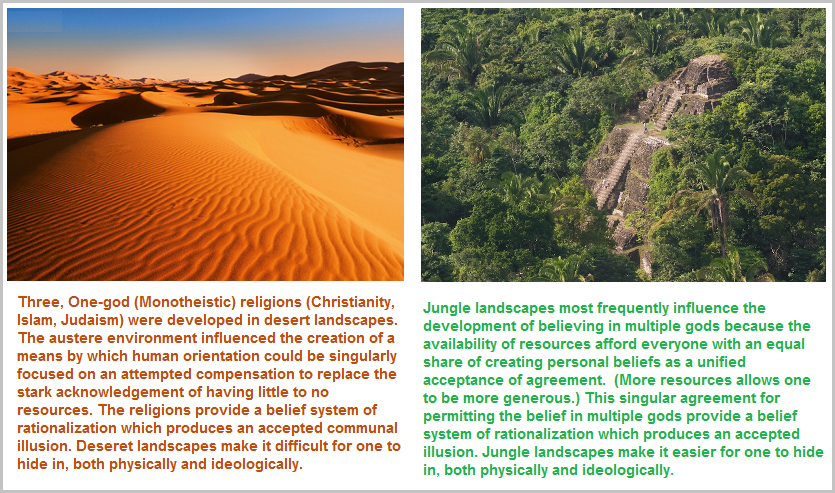
Date of Origination: Sunday, 16th February 2020... 7:59 AM
Initial Posting: Wednesday, 19th February 2020... 6:41 AM
Updated Posting: Thursday, 20th February 2020... 8:03 AM
Herb O. Buckland
herbobuckland@hotmail.com